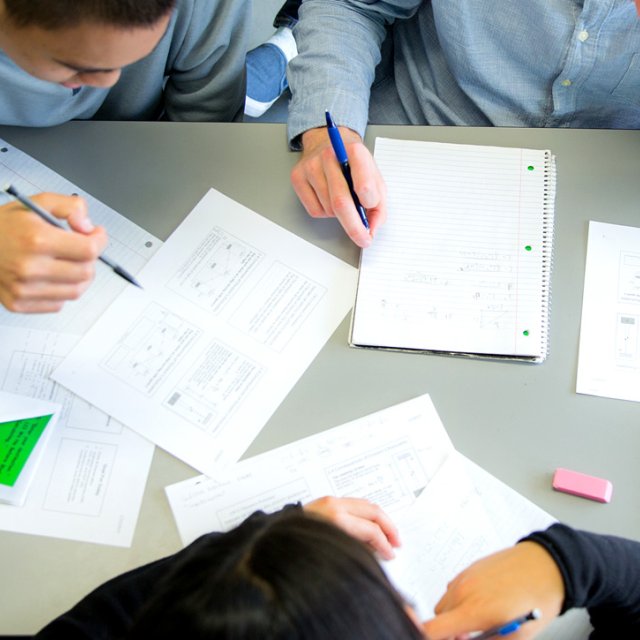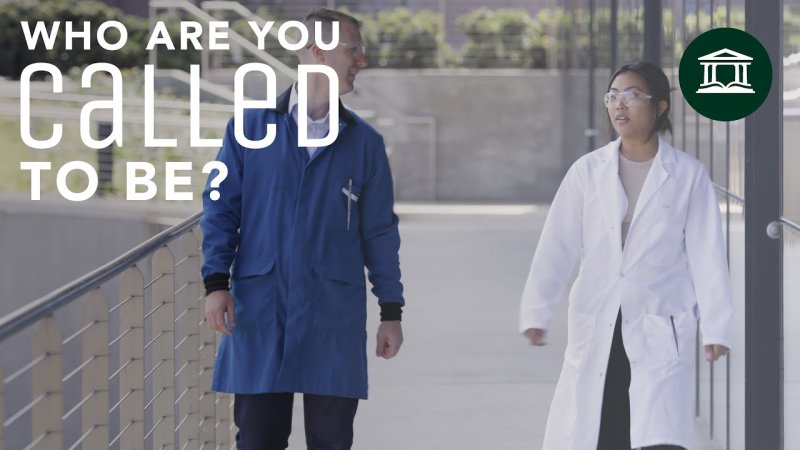
Students who pursue a major in the physics and engineering department have a unique opportunity to conduct research alongside experienced faculty. This student research involves the methodical formation of a scholarly honors project, the process and goal of which is to prepare students for the world of post-baccalaureate scholarship and research.
Some of PLNU’s physics and engineering majors engage in summer research with faculty at PLNU. Other students participate in Research Experiences for Undergraduates (REUs), which are generally held at major research universities and funded by agencies such as the National Science Foundation.
All research involves working closely with a faculty mentor on a research project, and the research generally culminates in a presentation of your findings. Many physics and engineering students turn their summer research projects into honors theses. In completing the thesis, you will be coached through the various stages of conducting a research project and transforming your work into a scholarly presentation and paper.
The Department of Physics & Engineering will strongly support you as a research student, and you can look forward to working with your faculty mentor throughout the research, editing, and presentation processes, all while gaining invaluable advice and guidance every step of the way.
2024-2025 Student Research
Low-Computation Microbial Detection and Classification for the Diagnosis of Urinary Tract Infections: A Deep Learning Approach
Vivyan Gripp, Jacob Rudd-Hicks, Alessandro Mendoza
Mentor: Dr. José Manjarrés
We trained and evaluated multiple deep learning models for smartphone-based bacterial identification from UTI culture images from lab-grown and patient-derived specimens. Utilizing this approach could lead to improved treatment, reduced diagnostic delays, and better health outcomes for individuals affected by UTIs globally.
Researching the uniformity and longevity of Tantalum-based Josephson Junctions (JJs)
Kyle Dramov
Mentor: Dr. Anthony Cortez
This summer, I had the opportunity to work at the Naval Information Warfare Center (NIWC) Pacific on a project researching the uniformity and longevity of Tantalum-based Josephson Junctions (JJs). JJs are a leading candidate for creating qubits, the fundamental building blocks of quantum computers. In 2023, NY CREATES, a prominent semiconductor fabrication facility, sent chips with varying barrier thicknesses (5 nm, 6 nm, and 7 nm) to NIWC for analysis. Samples were stored at room temperature and ambient air pressure for two years. I was tasked with assessing whether the JJs had undergone any changes to their electrical properties. To characterize potential changes, I measured the normal-state resistance of the JJs at different temperatures using a CRX-4K cryogenic probe station equipped with four DC probes. I obtained resistance measurements at room temperature (approximately 300 K) and at 4.6 K, then calculated the percentage increase in resistance to quantify the changes in the JJs. Looking ahead, the next step is to place the JJs in a dilution refrigerator to observe changes when cooled to the millikelvin range. This work advances the study of Tantalum-based Josephson Junctions and their application in quantum devices, and also strengthens the collaboration between PLNU, NY CREATES, and NIWC.
2023-2024 Student Research
Analyzing Doxorubicin-loaded PLGA Nanoparticles to Mitigate Cardiotoxicity on Murine Cardiomyocytes using Machine Learning Modeling
Christina Lee and Jenny McCreary
Mentor: Dr. José Manjarrés
Summer Research Performed at PLNU
Identification of Bacterial Strains Using an Instance Segmentation Model
Carter Davis and Alexey Lange
Mentor: Dr. José Manjarrés
Summer Research Performed at PLNU
This team worked with a customer to convert a trick scooter with wheels into one that can be used on ice with blades. The project involved designing the connectors between the scooter and front and back blades, mocking up several different designs using a 3D printer, finalizing the design and delivering a working prototype to the customer.
Paul Towne and Patrick Tucker
Mentor: Dr Maria Zack
Summer Research Performed at PLNU
2022-2023 Student Research
Developing a Python Program for Resistance vs Temperature Measurements
Jenny McCreary
Mentor: Dr. Anthony Cortez
Summer Research Performed at PLNU
Cryogenic Probe Design for Thin Film Measurements
Paul Towne
Mentor: Dr. Antony Cortez
Summer Research Performed at PLNU
Designing and Implementing an Electrical Transport Measurement Station for Thin Films
Lily Damron
Mentor: Dr. Anthony Cortez
Summer Research Performed at PLNU
2020-21 Student Research
Maker Space Development
Caedin Miller
Mentors: Dr. Paul Schmelzenbach
Summer Research Performed at PLNU
Maker Space Development
Lincoln Gillette
Mentors: Dr. Paul Schmelzenbach
Summer Research Performed at PLNU
2019-20 Student Research
Effects of Time-Dependent Heat Sources On Neutron Star Crust Cooling
Austin Smith
Mentor: Dr. Heide Doss
Neutron star crust cooling can give insights to the interior composition of the stars. Using dStar and the neutron star cooling simulation code NSCool, a variable mass is accreted onto different neutron star models. Previous accretion simulations have commonly assumed a constant mass accretion over a long epoch; this research investigates the effects of different accreting mass accretion rate distributions and focuses on a periodic Gaussian distribution, with a finer time epoch. The simulations produce plots of mass accretion rate distributions as well as effective temperature and luminosity as viewed by a distant observer over time. The effects on the quiescent cooling curves due to the time-dependent distribution shapes of accreted mass are found to have only short time-scale effects, with differences only noticeable on timescales as on the order of the accretion events.
A Study in Securing the Internet of Things
Joey Tuttobene
Mentor: Dr. Mike Leih
Current Internet of Things (IoT) cybersecurity threats were investigated using current literature and direct examination of IoT devices including the 3D printer control software OctoPrint, the autonomous vehicle middleware MOOS-IvP, and a common consumer smart lightbulb. This research found that most IoT devices transmit in plaintext and that software controls alone are insufficient in control systems applications. Recommended best practices for organizations include segregating IoT devices on a network, using non-default credentials, and keeping devices up to date. Manufacturers need to include robust encryption and authentication of messages with their offerings, as well as provide methods to update devices easily and safely. Finally, physical fail-safes can complement imperfect software in IoT control system applications.
Can we use Transfer Learning to Implement a Convolutional Neural Network to do Large Mammal Classification on an Edge Device?
Noah Cole
Mentor: Dr. Ryan Botts
Conservation efforts of large mammal species in Costa Rica rely on extensive camera tracking networks to record these species’ presence, activity, and interactions. By using transfer learning on an edge device to retrain a Convolutional Neural Network the process of tracking and identifying these mammals will be streamlined. Transfer learning on edge devices was found to be effective in retraining and deploying CNN image classifiers.
Characterizing a distributed pressure sensor built from off-the-shelf piezoresistive polymer
TJ Wiegman
Mentor: Dr. Tom Carter
Measuring the distribution of mechanical pressure across a surface is useful in a wide variety of applications, but traditional measurement tools are either very expensive or single-use. Here we characterize a exible, reusable sensor built from off-the-shelf materials that is simple and low-cost, but unsuited for high-precision work.
Converting Introduction to Engineering I and Mechanics of Materials labs to online/hybrid format
Noah Castellon
Mentors: Dr. Paul Schmelzenbach and Dr. Michelle Chen
Summer Research Performed at PLNU
Converting Introduction to Engineering I and Mechanics of Materials labs to online/hybrid format
Caedin Miller
Mentors: Dr. Michelle Chen and Dr. Paul Schmelzenbach
Summer Research Performed at PLNU
Converting Electronics Circuits Analysis labs to online/hybrid format
Abel Haynes
Mentor: Dr. Tom Carter
Summer Research Performed at PLNU
Converting University Physics I labs to online/hybrid format
Levi Mcclurg
Dr. Michelle Chen
Summer Research Performed at PLNU
2018-19 Student Research
Mentor: Heide Doss
NOTE:
Although the initial research was suggestive of nuclear tracks, it was not definitive. Further experimentation on CR-39 showed that while the detector is good for detection of energetic particles due to nuclear processes in air, the tracks formed in an electrochemical cells are not distinguishable from tracks formed by non-nuclear processes as shown in the following APS 2020 March Meeting Poster Session: Investigation of Track Formation in CR-39 for Various Hydrated Environments
2017-18 Student Research
Engineering/Physics Galactic Cosmic Radiation Shielding Using Active and Passive Methods
Matthew Sailer
Mentor: Heide Doss
We consider the threat of radiation during space missions and review the different shielding methods proposed over the past 60 years. We propose a new method for shielding with the ability to harness useable electrical power and create thrust from the environment.
Chemistry/Physics Synthesis and Computational Analysis of Novel IspF Inhibitors
Daniel Harper
Mentor: Lane Votapka
The development of new antibiotics is time-intensive and costly. In this study, computer methods were combined with traditional experimental work to yield a more focused approach. When the experimentally synthesized molecules failed to yield the desired results, the computational results provided an explanation and a promising angle for future research.
Physics Exploratory Coordination Chemistry: Metal-Nitride Nanoclusters with Cobalt, Bismuth, and Titanium Species
Brendan Crabb
Mentor: Laurance Beauvais
In recent years, the study of nanoclusters has grown considerably because of their possible use in a wide range of applications. In this research, we are focused on preparing new titanium chloride precursors to titanium-nitride clusters. These molecules will be presented and possible synthetic routes to new nanoparticles will be discussed.
Maker Space Design and Alumni Outreach
Alexander Mathews
Mentor: Greg Crow and Maria Zack Research performed at PLNU
PLNU WIFI Data Analysis
Noah Cole and Isaac Hughes
Mentor: Greg Crow and Maria Zack
Research performed at PLNU
Instructional and Pedagogical Uses Amazon Web Services 2018
Joey Tuttobene
Mentor: Mike Leih
Research performed at PLNU
Automating Ground Station Communication with two of their CubeSats
Phillip Ward
Research performed at Montana State University’s Space Science and Engineering Laboratory
Enabled successful demonstrations of multi-modal subsea communications systems using very low frequency radio frequency, acoustic modems, and free space optics units.
Eric Lu
Research performed at SPAWAR
Graphene Synthesis, Characterization and Transferring
Madison Berger, Alex Koch, Estifanos Mekuria
Mentor: Michelle Chen
Research Performed at PLNU
Mobile App Creation for Android
Alex Mathews
Mentor: Lori Carter
Research Performed at PLNU
2016-17 Student Research
Graphene Synthesis, Transferring, and Characterization
Madison Berger, Alex Koch and Estifanos Mekuria
Research performed at PLNU
Development of IspF inhibitor
Daniel Harper
Research performed at PLNU
Graphene Synthesis by Chemical Vapor Deposition
Kathrine Quiros, Michael Lambert, Daniel Solar
Research performed at PLNU
Neural Network Compression
Richard Dallas Probert
Research performed at SPAWAR
Exploratory Coordination Chemistry: Metal Nitride Nanoclusters with Cobalt, Bismuth, & Titanium Specis
Brendan Crabb
Research performed at PLNU
2015–16 Student Research
Effect of Oxygen Concentration on Sonoluminescence at PLNU
David Graham, Dallas Probert, and Lindsey Watson
Research Performed at PLNU
Biomedical Physics — Fluorescent Dyes
Alyssa Forber
Research Performed at Texas Christian University
REU — Reaction Front Barriers in Vortex Domain Flows
Laura Skinner
Research Performed at Bucknell University
Structural Engineering
Daniel Sarkisian
Interned at CityScape Engineering for Research
Single Particle Structure of 209,210PbHg Investigated Through the Deep Inelastic Reaction 136Xe + 208Pb
Clayton Hamill
Research Performed at Brookhaven National Lab
Organocatalysis by Site-Isolated N-Heterocyclic Doped into the UIO-67 Framework
Brendan Crabb
Research Performed at PLNU
2014–15 Student Research
Constructing of and Initial Observations With a Sonoluminescence Chamber
Drew Eby, Alyssa Forber, and Laura Skinner
Research Performed at PLNU
First Principles Calculations for Nanostructured Thin Films
Carina Kazmierowick
Research Performed at the Center for Sustainable Materials Chemistry (CSMC), University of Oregon, UC Berkeley
Characterization of Al-doped Zinc Oxide for Transparent Conducting Oxides
Melanie Broman
Research Performed at Materials Science and Engineering REU, North Carolina State
2012–13 Student Research
Holographic Interferometry
James Carmichael
Research Performed at PLNU
Quantitative Imaging of Sm-153
Hannah Ponek
Research Performed in Medical Physics at John Hopkins University
Undergraduate Lab Curriculum Development
Joshua Ortega
Research Performed at PLNU
Study of Brownian Motion Through Video Analysis
Erik Tammaru
Research Performed at PLNU
Graphene Synthesis
Andrew Schalin and Joshua Wathen
Research Performed at PLNU
2011–12 Student Research
Graphene Synthesis
Hannah Ponek
Research Performed at PLNU
Conservation of Water and Electricity for New Building Sites
Derek Richdale
Research Performed at Texas A&M
Structural Response to Earthquakes
Kurt Kellogg
Research Performed at UCLA
Robotic Controlled Quadrotor
Austin Timm
Research Performed at PLNU
